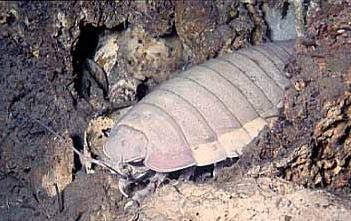·hydrothermal· ·vents·
Creatures of hydrothermal vents
·media·
·link·
Creatures of Hydrothermal Vents
At these tremendous depths, one cannot simply scuba dive to recorded findings. So with aid from Alvin, a 3-person submersival, scientists make recordings of what they find.
The mid ocean ridge system extends 40,000 miles, with only a mere 4,000 of that explored in two decades. In this short amount of time many living creatures have been seen thriving around the vents. Amazingly, 300 species in 90 genre have been identified.
 Growth
is surprisingly quick for these depths, which do not receive any sunlight.
Unlike animals and plants above the greound, these creatures live on chemosynthesis
instead of photosynthesis. A sulfite chimney can grow over 10 meters tall.
On one expedition, Alvin accidentally broke a 10 meter chimney. Two months
later on another expedition they went back to the broken chimney and 7
meters had regrown. The vents were not the most surprising find to the
scientists. that award went to the red-tipped giant tube worms.
Growth
is surprisingly quick for these depths, which do not receive any sunlight.
Unlike animals and plants above the greound, these creatures live on chemosynthesis
instead of photosynthesis. A sulfite chimney can grow over 10 meters tall.
On one expedition, Alvin accidentally broke a 10 meter chimney. Two months
later on another expedition they went back to the broken chimney and 7
meters had regrown. The vents were not the most surprising find to the
scientists. that award went to the red-tipped giant tube worms.
At these depths, giant tube worms have been measured up to 12 feet tall containing around 300,000 tentacles. This size and amount can be compared to the shallow depth tube worms which contain a dozen or so tentacles and grow to a few inches in height. These animals have no mouth to eat with or anus to discharge excess. They use dissolved gasses around vents, namely hydrogen sulfide, carbon dioxide and oxygen. They soak up the nutrients they need through their tissues and transport them in their bloodstream. Growing at one inch per year, scientists predict that some of the worms are over a hundred years old.
 Another
species that has grown to remarkable size is the clam. These giant clams
can grow up to ten inches in length. They are endemic (they live around
the vents full time) as are the worms and snails. Some visitors that stop
by to eat include pink ventfish, sea cucumbers, blind and spider crabs,
octopi, shrimp, sponges, and brittle stars to name a few. Giant isopods
grow up to ten inches in length compared to the ones kids stomp on which
are an inch or so.
Another
species that has grown to remarkable size is the clam. These giant clams
can grow up to ten inches in length. They are endemic (they live around
the vents full time) as are the worms and snails. Some visitors that stop
by to eat include pink ventfish, sea cucumbers, blind and spider crabs,
octopi, shrimp, sponges, and brittle stars to name a few. Giant isopods
grow up to ten inches in length compared to the ones kids stomp on which
are an inch or so.
These amazing creatures have raised many questions. One of the first was how did life begin in this environment? Life began with bacteria that metabolizes hydrogen sulfide. The bacteria, in return, became food for the other animals in the community. Some argue that the bacteria found here could contain clues to how life first formed on planet Earth. Colonization begins when bacteria populate to the vents. Then other microorganisms, including amphipods and copepods appear. Followed by shrimp, crabs, snails, and worms. These creatures come to feed on the bacteria. Larger prey, such as fish and octopi come to feed on them.
